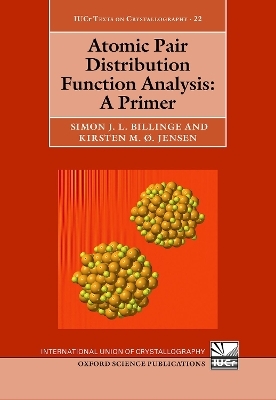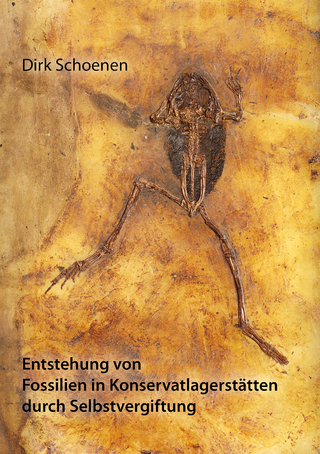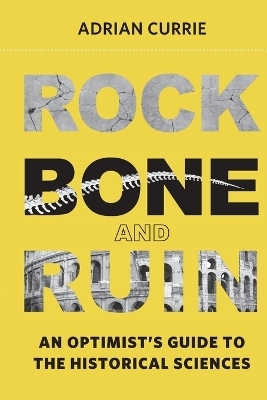
Atomic Pair Distribution Function Analysis
Oxford University Press (Verlag)
978-0-19-888580-1 (ISBN)
Since the early 1990s the atomic pair distribution function (PDF) analysis of powder diffraction data has undergone something of a revolution in its ability to do just that: yield important structural information beyond the average crystal structure of a material. With the advent of advanced sources, computing and algorithms, it is now useful for studying the structure of nanocrystals, clusters and molecules in solution or otherwise disordered in space, nanoporous materials and things intercalated into them, and to look for local distortions and defects in crystals. It can be used in a time-resolved way to study structural changes taking place during synthesis and in operating devices, and to map heterogeneous systems.
Although the experiments are somewhat straightforward, there can be a gap in knowledge when trying to use PDF to extract structural information by modelling. This book addresses this gap and guides the reader through a series of real life worked examples that gradually increase in complexity so the reader can have the independence and confidence to apply PDF methods to their own research and answer their own scientific questions.
The book is intended for graduate students and other research scientists who are new to PDF and want to use the methods but are unsure how to take the next steps to get started.
Professor Billinge has dedicated his life to finding and characterizing local structures, local distortions and hidden symmetries in materials. It all started with an undergrad in Metallurgy and Materials Science at Oxford University, then a PhD at University of Pennsylvania. This led to an interest in the physics of materials and the physics of scattering and a 13 year stint in a Physics and Astronomy Department at Michigan State University. Since 2008 he has been in his current position at Columbia University, with an additional 14 year joint appointment at Brookhaven National Laboratory. He is best known for his contributions to the development of the PDF method, the topic of this book, into a powerful modern materials characterization tool. Kirsten M. Ø. Jensen's undergraduate and PhD studies were both completed at Aarhus University in Denmark, graduating in 2013. She was at this point already very interested in structure/property relations in nanoscale materials, and after her PhD, she joined Prof. Billinge's group at Columbia University for a postdoctoral fellowship. She has been at University of Copenhagen since 2015 where she leads her research group. She is known for her innovative application of x-ray scattering methods, and especially PDF analysis, to problems in nanomaterials chemistry.
1: Introduction and review
1.1 What this book is not
1.2 What this book is
1.3 Why PDF?
1.4 Software
2: PDF Primer
2.1 Introduction
2.2 X-ray scattering from materials
2.3 Obtaining the PDF from x-ray total scattering data
2.4 The pair distribution function
2.5 Extracting structural information from the PDF
2.6 Measurement of total scattering data
2.7 It is time to start modelling!
3: PDF modelling of simple crystal structures: Bulk Ni and Pt nanoparticles
3.1 Introduction and overview
3.2 The question
3.3 The result
3.4 The experiment
3.5 What next?
3.6 Wait, what? How do I do that?
3.7 Problems
3.8 Solution
3.9 Diffpy-CMI solution
4: Getting the PDF
4.1 Introduction and overview
4.2 The question
4.3 The result
4.4 The experiment
4.5 What next?
4.6 Wait, what? How do I do that?
4.7 results
4.8 problems
4.9 solution
5: Quantification of sample phase composition: physical mixtures of Si and Ni
5.1 Introduction and overview
5.2 The question
5.3 The result
5.4 The experiment
5.5 What next?
5.6 Wait, what? How do I do that?
5.7 Problems
5.8 Solution
5.9 Diffpy-CMI Solution
6: More advanced crystal structure modeling: the room-temperature structure of crystalline Ba0.7K0.3(Zn0.85Mn0.15)2As2
6.1 Introduction and overview
6.2 The question
6.3 The result
6.4 The experiment
6.5 What next?
6.6 Wait, what? How do I do that?
6.7 Problems
6.8 Solution
6.9 Diffpy-CMI Solution
7: Investigating the tetragonal-to-orthorhombic phase transition in SrFe2As2
7.1 Introduction and overview
7.2 The question
7.3 The result
7.4 The experiment
7.5 What next?
7.6 Wait, what? How do I do that?
7.7 Problems
7.8 Solution
7.9 Diffpy-CMI Solution
8: Simple modeling of nanoparticles: Size-dependent structure, defects and morphology of quantum dot nanoparticles
8.1 Introduction and overview
8.2 The question
8.3 The result
8.4 The experiment
8.5 What next?
8.6 Wait, what? How do I do that?
8.7 Problems
8.8 Solutions
8.9 Diffpy-CMI Solution
9: Local structure in a crystal with short-range ordered lower-symmetry domains: Local iridium dimerization and triclinic distortions in cubic CuIr1.76Cr0.24S4
9.1 Introduction and overview
9.2 The question
9.3 The result
9.4 The experiment
9.5 What next?
9.6 Wait, what? How do I do that?
9.7 Problems
9.8 Solution
9.9 Diffpy-CMI Solution
10: Nano and polycrystalline thin films: Local structure of nanocrystalline TiO2 grown on glass
10.1 Introduction and overview
10.2 The question
10.3 The result
10.4 The experiment
10.5 What next?
10.6 Wait, what? How do I do that?
10.7 Problems
10.8 Solution
10.9 Diffpy-CMI Solution
11: Structure of discrete tetrahedral quantum dots: Atomically precise CdSe tetrahedral nanoclusters
11.1 Introduction and overview
11.2 The question
11.3 The result
11.4 The experiment
11.5 What next?
11.6 Wait, what? How do I do that?
11.7 Problems
11.8 Solution
12: Structure and intercalation environment of disordered layered materials: zirconium phosphonateDSphosphate unconventional MOFs
12.1 Introduction .
12.2 The question
12.3 The result
12.4 The experiment
12.5 What next?
12.6 Wait, what? How do I do that?
12.7 Problems
12.8 Solution
13: Magnetic PDF
13.1 Introduction and overview
13.2 The question
13.3 The result
13.4 The experiment
13.5 What next?
13.6 Wait, what? How do I do that?
13.7 Problems
13.8 Solution
14: Tips and Tricks: PDF measurements
14.1 Introduction and overview
14.2 Basic overview: what are total scattering data?
14.3 What type of radiation should I use?
14.4 Detectors
14.5 Sample geometries
14.6 Samples
14.7 Sample environments
15: More PDF Tips and Tricks
15.1 Introduction
15.2 PXRD or PDF, Q-space or r-space analysis?
15.3 Model-free analysis of PDF
15.4 More options for PDF modelling
15.5 Automated PDF modelling
15.6 Final words
16: Appendix 1: Python
16.1 Introduction
16.2 Installing Python programs
16.3 The terminal and the command prompt
16.4 Python IDE>'s and Jupyter Notebooks
17: Appendix 2: Data processing and integration
17.1 Introduction
Bibliography
| Erscheinungsdatum | 25.11.2023 |
|---|---|
| Reihe/Serie | International Union of Crystallography Texts on Crystallography ; 22 |
| Zusatzinfo | 41 line drawings and halftones |
| Verlagsort | Oxford |
| Sprache | englisch |
| Maße | 175 x 254 mm |
| Gewicht | 682 g |
| Themenwelt | Naturwissenschaften ► Geowissenschaften ► Mineralogie / Paläontologie |
| Naturwissenschaften ► Physik / Astronomie ► Festkörperphysik | |
| Naturwissenschaften ► Physik / Astronomie ► Thermodynamik | |
| ISBN-10 | 0-19-888580-6 / 0198885806 |
| ISBN-13 | 978-0-19-888580-1 / 9780198885801 |
| Zustand | Neuware |
| Haben Sie eine Frage zum Produkt? |
aus dem Bereich


